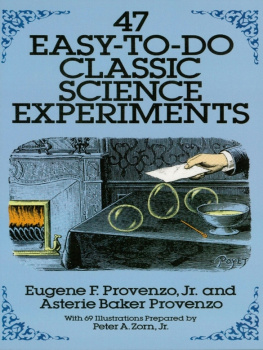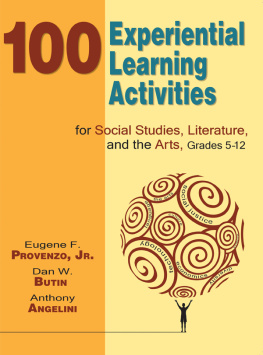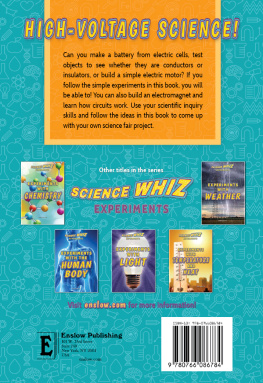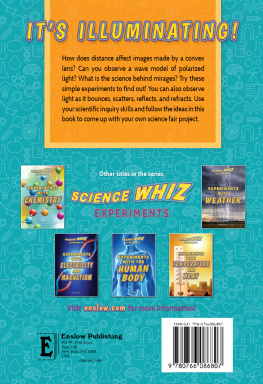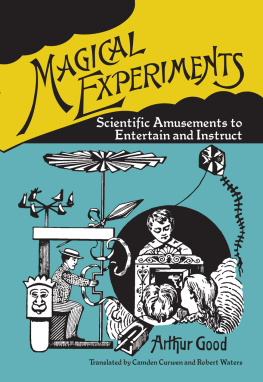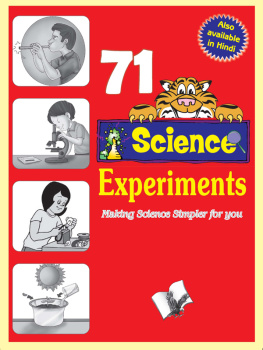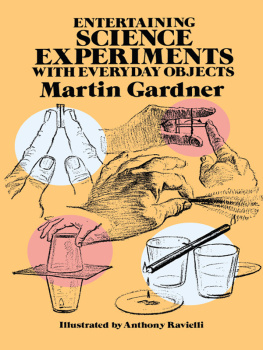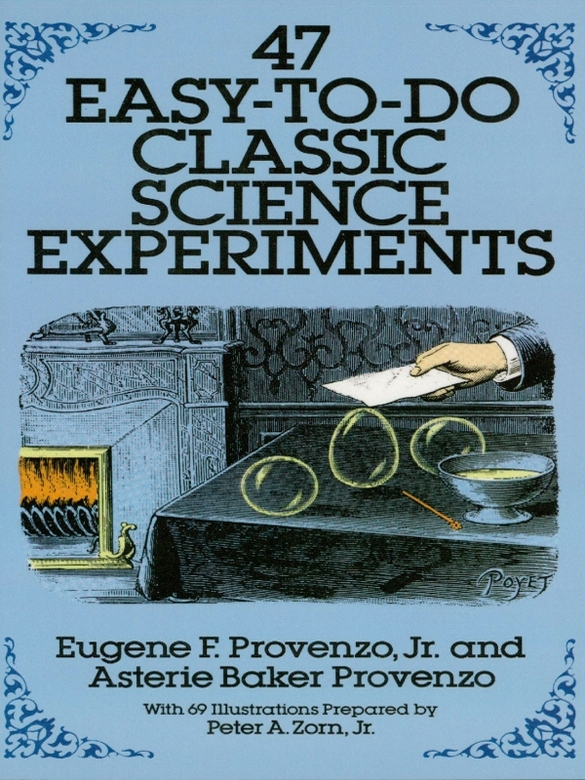Sources of Historical Illustrations
Titles in quotation marks are of sections in this book, according to the order of which the following list is organized.
How Many Quarters Will a Glass Full of Water Hold? Gaston Tissandier, Les Recreations Scientifiques (Paris: G. Masson Editeur, 1881), p. 4.
Floating Needle. Tom Tit [Arthur Good], La Science Amusante, Premire Srie; 100 Nouvelles Expriences (Paris: Librairie Larousse, 1890), n.p.
Snuffing a Candle with a Soap Bubble. Tom Tit [Arthur Good], La Science Amusante, Deuxime Srie; 100 Nouvelles Expriences (Paris: Librairie Larousse, 1892), p. 143.
Motorized Paper Fish. Tom Tit [Arthur Good], La Science Amusante, Premire Srie; 100 Nouvelles Expriences (Paris: Librairie Larousse, 1890), n.p.
Perpetual Dancers. Tom Tit [Arthur Good], La Science Amusante, Troisime Srie; 100 Nouvelles Expriences (Paris: Librairie Larousse, [1894?]), p. 37.
Air Boils Water. Tom Tit [Arthur Good], La Science Amusante, Troisime Srie; 100 Nouvelles Experiences (Paris: Librairie Larousse, [1894?]), p. 23.
Air Holds Up Water. Gaston Tissandier, Les Rcrations Scientifiques (Paris: G. Masson Editeur, 1881), p. 34.
Magdeburg Sphere. Scientific American Supplement 618 (November 5, 1887), p. 9877.
Simple Diving Bell. Gaston Tissandier, Popular Scientific Recreations [trans. Henry Frith] (New York: Ward, Lock, and Co., [1890?]), title page.
Cartesian Diver. Gaston Tissandier, Les Rcrations Scientifiques (Paris: G. Masson Editeur, 1881), p. 334.
Soap-Bubble Passenger. Scientific American Supplement 608 (August 27, 1887), p. 9716.
Suspended Pea. Scientific American, May 28, 1887, p. 342.
Blowing an Egg Out of a Cup. Scientific American Supplement 243 (August 28, 1880), p. 1.
Air Glue. Scientific American Supplement 279 (May 7, 1881), p. 4448.
3-D Vision. Tom Tit [Arthur Good], La Science Amusante , Deuxime Srie; 100 Nouvelles Expriences (Paris: Librairie Larousse, 1892), p. 135.
Thaumatrope. Gaston Tissandier, Les Rcrations Scientifiques (Paris: G. Masson Editeur, 1881), p. iii.
Moving-Picture Machine. Scientific American, November 26, 1881, p. 338.
Distorted Picture. The Boys Own Book , 7th ed. (London: Vizetelly, Branston and Co., 1831), n.p.
Color Tops. J. C. Maxwell, Scientific Papers of James Clerk Maxwell, ed. by W. P. Niven (Cambridge: Cambridge University Press, 1890), part I, p. 127.
Newtons Rings. Tom Tit [Arthur Good], La Science Amusante, Troisime Srie; 100 Nouvelles Expriences (Paris: Librairie Larousse, [1894?]), p. 133.
Distorted Images. Scientific American Supplement (May 7, 1881), p. 4448.
Detecting Static Electrical Charges. Tom Tit [Arthur Good], La Science Amusante, Deuxime Srie; 100 Nouvelles Expriences (Paris: Librairie Larousse, 1892), p. 113.
Electrified Dice. Tom Tit [Arthur Good], La Science Amusante, Troisime Srie; 100 Nouvelles Expriences (Paris: Librairie Larousse, [1894?]), p. 95.
Dancing Soap Bubbles. Tom Tit [Arthur Good], La Science Amusante, Troisime Srie; 100 Nouvelles Expriences (Paris: Librairie Larousse, [1894?]), p. 131.
Floating Magnets. Scientific American, February 12, 1887, p. 105.
Water That Wont Spill. Tom Tit [Arthur Good], La Science Amusante, Premire Srie; 100 Nouvelles Expriences (Paris: Librairie Larousse, 1890), p. 151.
Magic with Coins. Scientific American Supplement 608 (August 27, 1887), p. 9716.
More Magic with Coins. Scientific American Supplement 608 (August 27, 1887), p. 9716.
Elevated Napkin Ring. Scientific American Supplement 279 (May 7, 1881), p. 4448.
Magic with Checkers. Scientific American Supplement 247 (September 25, 1880), p. 3930.
Immovable Quarter. Scientific American, March 26, 1887, p. 201.
Spinning Marble. Scientific American Supplement 321 (February 25, 1882), p. 5122.
Ringing Spoon. Scientific American Supplement 232 (June 12, 1880), title page.
String Telephone. Scientific American, February 19, 1887, p. 121.
Glass Harmonica. Scientific American Supplement 266 (February 5, 1881), p. 4238.
Dancing Wire. Tom Tit [Arthur Good], La Science Amusante, Troisime Srie; 100 Nouvelles Expriences (Paris: Librairie Larousse, [1894?]), p. 91.
A Simple Phonograph. Scientific American, July 6, 1878, p. 5.
Uphill-Rolling Object. Tom Tit [Arthur Good], La Science Amusante, Deuxime Srie; 100 Nouvelles Expriences (Paris: Librairie Larousse, 1892), p. 15.
Mixing a Liquid Parfait. Tom Tit [Arthur Good], La Science Amusante, . Deuxime Srie; 100 Nouvelles Expriences (Paris: Librairie Larousse, 1892), p. 19.
Acrobatic Coin. Scientific American Supplement 618 (November 5, 1887), p. 9877.
Domino Acrobatics. Scientific American Supplement 297 (September 10, 1881), n.p.
Slipping Through an Index Card. Tom Tit [Arthur Good], La Science Amusante , Premire Srie; 100 Nouvelles Expriences (Paris: Librairie Larousse, 1890), p. 223.
Burning Lenses and Mirrors. Tom Tit [Arthur Good], La Science Amusante, Deuxime Srie; 100 Nouvelles Expriences (Paris: Librairie Larousse, 1892), p. 129.
Drawing an Ellipse. Tom Tit [Arthur Good], La Science Amusante, Troisime Srie; 100 Nouvelles Expriences (Paris: Librairie Larousse, [1894?]), p. 157.
Straw Lever. Scientific American Supplement 247 (September 25, 1880), p. 3930.
Hot-Air Detector. Scientific American Supplement 279 (May 7, 1881), p. 4448.
Moisture-detecting Mermaid. Scientific American, January 22, 1887, p. 56.
Surface Tension
How Many Quarters Will a Glass Full of Water Hold?
Science makes it possible to perform some wonderful tricks on your friends. For example, suppose you fill a glass with water right to the top. Then ask a friend how many quarters they think you can drop into the glass without causing the water to overflow. No doubt, they will say one or two. The fact is, as the illustration below shows, the answer is more like ten!
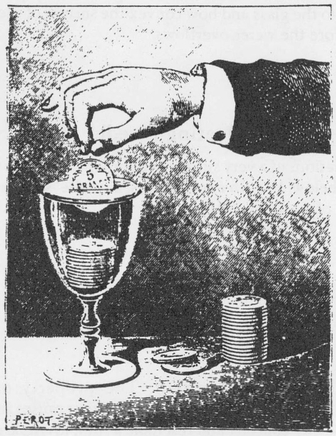
How to Drop Quarters Into a Full Glass of Water Without Causing It to Overflow
| MATERIALS | ten to twelve quarters
glass full of water |
| KEY TERMS | Surface tension: The property of a liquid (possessed by all liquids) that causes its surface to contract and resemble a thin, invisible elastic skin. |
| Convex: Curved outward. |
| WHAT WILL BE DISCOVERED | The surface tension of the water allows the surface to stretch to a high, convex shape before it breaks and the water overflows. |
Be sure that the glass is filled with water to the very rim. The surface of the water should be slightly convex.
Carefully, with a steady hand, drop one quarter into the water. Add another and another to the water. As the coins are dropped into the water, you will be able to see that the surface of the water is becoming more and more convex owing to the principles of gravity and surface tension. It will be astonishing how many quarters can be dropped into the glass and how convex the surface of the water will become before the water overflows.
Floating Needle
Two variations of a very simple experiment in surface tension are illustrated below. In both experiments, a needle is made to float on the surface of water in a glass.
How to Float a Needle on Water

